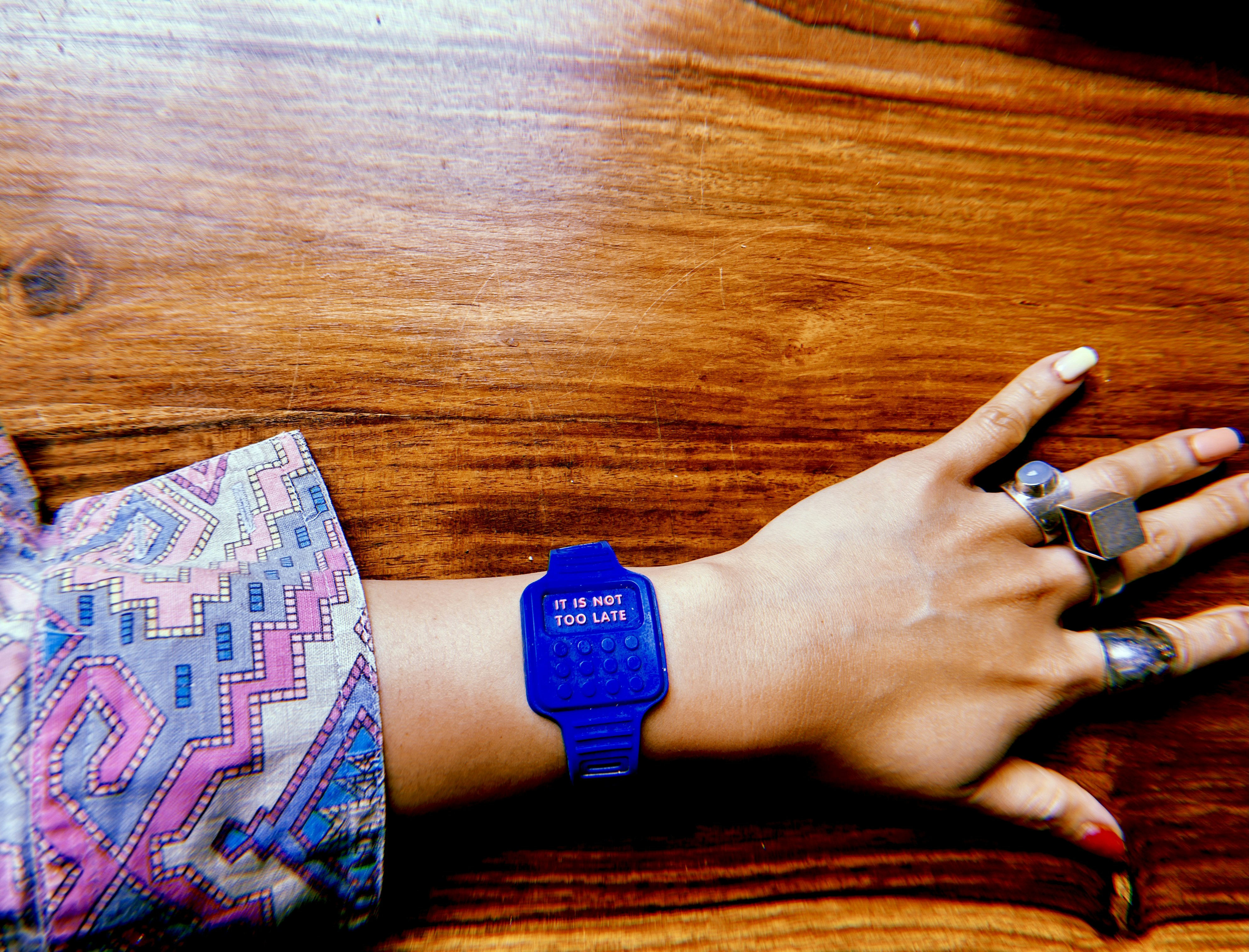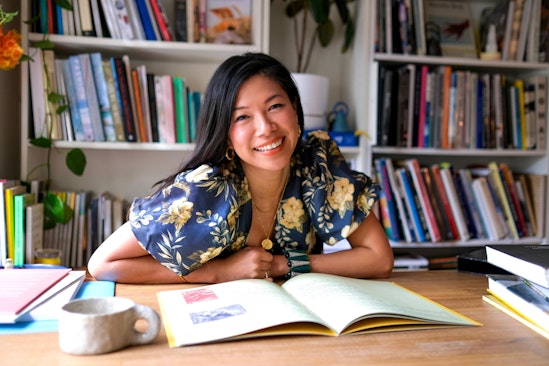Letter from the Editor
Mariam Ella Arcilla

A faux digital watch resting on the author's arm, with the line 'It is not too late' beaming on the screen instead of hours and minutes. Photo: Mariam Arcilla
It’s all about timing. Which is what my old, battered analogue watch told me as it went kaput—bang on 11:11am. Auspiciously, this tick-tock death happened the week I went into lockdown in March 2020, when the coronavirus pandemic encroached upon Sydney. My watch repair plans fizzled after I started noticing, like many people did, that time itself took on different shapes during social distancing; including the unspared art world. Exhibition dates were postponed and postponed again; galleries wound back opening hours; festivals slipped into hiatus (“we’ll be back in 2021, maybe 2022”); and global-travelling projects vanished. But heartening things also surfaced during this limbo: A slowing-down of time gave many artists a manna for rest, stillness, and recalibration. Museums used lull time to ramp up digitise archives. Performers beamed free at-home concerts. Activists amplified social media to mobilise communities and birth tangible civic change. Curators hopped on platforms, not planes, to help artists keep active and satiated across timezones and borders.
4A Papers exists to chronicle these times. Our bi-annual publication catalyses the ideas, movements, actions, and networks of an Asian region in constant flux. Issue 9 continues this praxis by spotlighting stories dispatched from Kuala Lumpur, Beijing, Sarawak, Manila, Almaty, Melbourne, and Sydney. Narratives that are foregrounded by local introspection, but with universal themes that transcend territories. Ultimately, what these stories tell us is that, although our bodies can’t travel far during this pandemic, our minds can still be transported.
4A Papers takes flight through five perspectives: NOW, THEN, MAKE, TALK, SEE.
For NOW, Eunice Andrada writes about her pursuit for an equitable world for people of colour through acts of social justice, collective labour, and community organisation. Galvanised by her lived experiences and kinship with literary collectives, the Filipina poet and educator proposes decolonial and decentralised programs that help dismantle systemic racism and elevate marginalised voices.
Time heals all wounds, as the adage goes. But how does one grieve during a time suspended by social distance and closed borders? Australian researcher and writer Luise Guest preludes her essay with a lamentation on her late mother, and the catharsis that arises through her earnest TALKs with Chinese artists Cao Yu 曹雨, Liu Xi 柳溪, and Ma Qiusha 马秋莎 about the matrilineal themes in their practices. These interviews, Guest says, “echoed my sense of being adrift in a melancholy sea, focused on mother-daughter relationships that are no less powerful in memoriam.”
For MAKE, Mohamad Faizuan Bin Mat draws us into his hometown of Karabong, a small coastal town in Sarawak. His diaristic survey explores the usungan, a grandly-decorated human transportation sculpture co-created by villagers, and paraded through neighbourhoods to celebrate weddings and end-of-school studies in his Malaysian hometown. Now a university lecturer, artist and curator, Bin Mat fondly recalls the boat-shaped usungan from his childhood—an ode to his fisherman father—and the legacies of creative-exchange and family ambition that have kept this festive tradition alive and unique to Borneo Island.
Over in Central Asia, art consultant and curator Vladislav Sludskiy makes an impassioned case for Kazakhstan’s underrepresented culture scene, via an eclectic index of artists and collectives that offer a socio-economic window into this vast and curious region. Among the zeitgeists featured in his roll-call are shamanistic artist Moldakul Narymbetov, the commune-dwelling transavantgarde members of Kyzyl Tractor Art Group, and Yelena & Victor Vorobyev, a husband-and-wife duo who explore “the ways in which ideology leaks into pop culture and national symbolism.” Almaty-based Sludskiy rounds out his text for NOW with a snapshot of galleries and platforms working instrumentally to elevate Central Asian artists locally and around the world.
Closer to home (4A’s Sydney home, that is), dance maker, artist-researcher, and 4A curator Reina Takeuchi unravels the rising phenomenon of online dance classes during quarantine, via her interviews with fellow dance makers Yumi Umiumare, Nikaio Thomashow, and Deborah Lemuel. Meditating on the “recurrent themes of home, forgiveness and rest” that drive their work, Takeuchi explores how their embodied practices empower participants to SEE new ways of body echolocation within the confines of domestic spaces.
We wrap up Issue 9 by bidding a bittersweet farewell to 4A Director, curator, and researcher Mikala Tai, after five adrenalising years at the helm of our organisation. In one of her last creative outputs for 4A, Tai pens a moving tribute to the indefatigable Malaysian arts patron Valentine Willie, and his Herculean contribution to Southeast Asia’s arts landscape over the past 25 years. For THEN, Tai traces Willie’s remarkable career as a family-lawyer-turned-art-dealer, and how his namesake galleries in Singapore, Manila, Kuala Lumpur, and Yogyakarta turned him into one of the region’s most effervescent cultural advocates.
Serendipitously, as I write my first Letter as the incoming Editor of 4A Papers, it’s not lost on me that today happens to be 11 November (11th day of the 11th month), which represents fresh beginnings and new manifestations for numerology fans. Perhaps my watch didn’t break after all. Maybe it froze at the right moment to remind me that time keeps on ticking; it’s just a different rhythm now.
Time for new beginnings. Time to reset.
Notes
Thanks to Sue Acret for her copy-editing assistance with 4A Papers: Issue 9.
About the contributor
Mariam Ella Arcilla is a Filipino-Singaporean arts & culture worker oscillating across programming, writing, communications and marketing, gallery management, and digital strategy. She creates on unceded Gadigal land.
